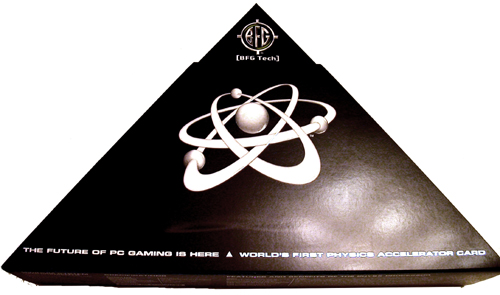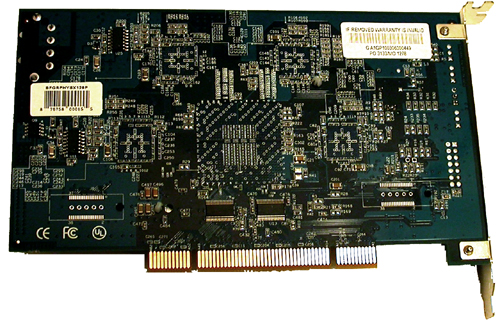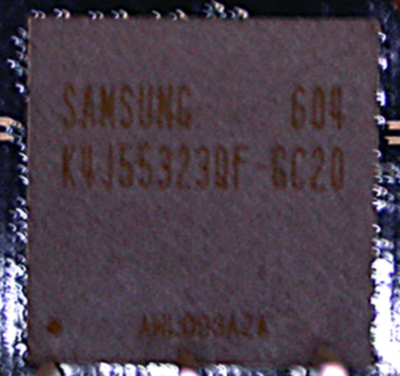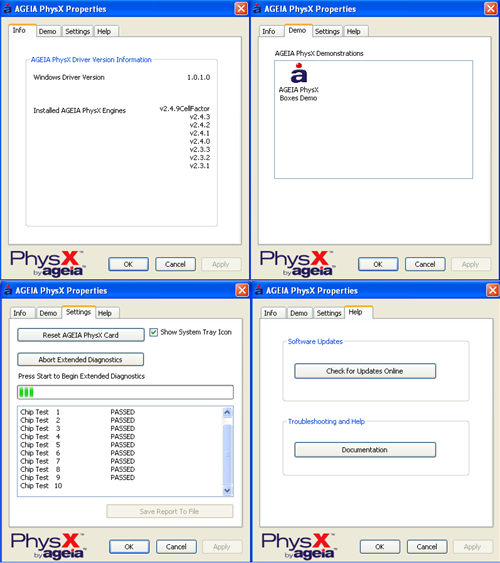BFG PhysX and the AGEIA Driver
Let us begin with the BFG PhysX card itself. The specs are the exact same as the ASUS card we previewed. Specifically, we have:130nm PhysX PPU with 125 million transistors
128MB GDDR3 @ 733MHz Data Rate
32-bit PCI interface
4-pin Molex power connector
The BFG card has a bonus: a blue LED behind the fan. Our BFG card came in a retail box, pictured here:

Inside the box, we find CDs, power cables, and the card itself:


As we can see here, BFG opted to go with Samsung's K4J55323QF-GC20 GDDR3 chips. There are 4 chips on the board, each of which is 4 banks of 2Mb x 32 RAM (32MB). The chips are rated at 2ns, giving a maximum clock speed of 500MHz (1GHz data rate), but the memory clock speed used on current PhysX hardware is only 366MHz (733MHz data rate). It is possible that lower than rated clock speeds could be implemented to save on power and hit a lower thermal envelope. It might be possible that a lower clock speed allows board makers to be more aggressive with chip timing if latency is a larger concern than bandwidth for the PhysX hardware. This is just speculation at this point, but such an approach is certainly not beyond the realm of possibility.

The pricing on the BFG card costs about $300 at major online retailers, but can be found for as low as $280. The ASUS PhysX P1 Ghost Recon Edition is bundled with GRAW for about $340, while the BFG part does not come with any PhysX accelerated games. It is possible to download a demo of CellFactor now, which does add some value to the product, but until we see more (and much better) software support, we will have to recommend that interested buyers take a wait and see attitude towards this part.
As for software support, AGEIA is constantly working on their driver and pumping out newer versions. The driver interface is shown here:
 |
| Click to enlarge |
There isn't much to the user side of the PhysX driver. We see an informational window, a test application, a diagnostic tool to check or reset hardware, and a help page. There are no real "options" to speak of in the traditional sense. The card itself really is designed to be plugged in and forgotten about. This does make it much easier on the end user under normal conditions.
We also tested the power draw and noise of the BFG PhysX card. Here are our results:
Noise (in dB)
Ambient (PC off): 43.4
No BFG PhysX: 50.5
BFG PhysX: 54.0
The BFG PhysX Accelerator does audibly add to the noise. Of course, the noise increase is nowhere near as bad as listening to an ATI X1900 XTX fan spin up to full speed.
Idle Power (in Watts)
No Hardware: 170
BFG PhysX: 190
Load Power without Physics Load
No Hardware: 324
BFG PhysX: 352
Load Power with Physics Load
No Hardware: 335
BFG PhysX: 300
At first glance these results can be a bit tricky to understand. The load tests were performed with our low quality Ghost Recon Advanced Warfighter physics benchmark. Our test "without Physics Load" is taken before we throw the grenade and blow up everything, while the "with Physics Load" reading is made during the explosion.
Yes, system power draw (measured at the wall with a Kill-A-Watt) decreases under load when the PhysX card is being used. This is made odder by the fact that the power draw of the system without a physics card increases during the explosion. Our explanation is quite simple: The GPU is the leading power hog when running GRAW, and it becomes starved for input while the PPU generates its data. This explanation fits in well with our observations on framerate under the games we tested: namely, triggering events which use PhysX hardware in current games results in a very brief (yet sharp) drop in framerate. With the system sending the GPU less work to do per second, less power is required to run the game as well. While we don't know the exact power draw of the PhysX card itself, it is clear from our data that it doesn't pull nearly the power that current graphics cards require.










67 Comments
View All Comments
hatsurfer - Thursday, May 18, 2006 - link
I just got my card today from Newegg. I only had about an hour to play before I left for work. I wanted to see the effects when I destroyed a building. I played through the first mission on 1600x1200 and my frames stayed a solid 30 with v-sync enabled due to playing on a large LCD. It was pretty nice to see the MANY building parts flying in every direction with the smoke effect. All in all it looked pretty cool and realistic. I am currently gaming on a EVGA 7800 GTX awaiting my 7900 GTX from EVGAs step-up program. I would like to take full advantage of my optimal resolution 1920x1200 but my frames dropped to the 20's. I can only imagine my 7900 GTX will get me my full HD resolution, which I can't sustain on a single 7800 GTX anyway.I think anyone with a high-end system isn't going to have any hangups when it comes to frame rates. Is this for low end budget gaming systems? Probably not just yet, but neither is the price tag of $300+. So, right now it's a nice little extra piece of eye candy for me to enjoy and in the end that's what is important anyway.
I hope this technology takes off and drives the number of supported titles up and if it gets incorporated into other components so be it (I really hope so too!). We'll just do another upgrade that we're all used to doing every few months anyway. Such it has always been at the cutting edge of PC'ing and such it will always be.
Mabus - Wednesday, May 17, 2006 - link
Well I wonder how long before ATI or Nvidia Buys this company and integrates the logic into it's GPU. Not only will this allow better performance but it will allow optimisations with drivers and communications and instruction exclusivity. This will be very nice smaller card, one less space used on mobo and cooler running etc etc..remember the seperate match co-pro well this tech will definatly go the same way, it is only a matter of time. And face it the current benchies show that time is what we need
to get that performance where us gamers want it.
Mabus signing off.....
Trisped - Wednesday, May 17, 2006 - link
Why didn’t you compare to stats of Asus card with those of the BFG card. Sound, power, if they are the same then say so, otherwise what is the point of reviewing two different cards for the same thing?COV is an unfair test- Max Physics Debris Count should be the same so you can see if there is a performance boost at the same level. I know that if I give my GPU 1000 more objects it is going to go much slower, with or without the PhysX card. What I want to see is running with 1500 and 422 “Debris” both with and without the card.
I would like to see the tests run with not only 2 different processors, but what about an Intel dual core and what about with different video card configurations? If you have a lower end video card should you expect to have less of an FPS impact or more?
How long before there is a PCIe card? Would there be a performance boost using PCIe? I would think that if the physics and GPU were on the same bus then there would be less latency as well as faster communication. I think the fact that the PhysX card wouldn’t have to wait for the processor to stop sending it info before it started transmitting would also be important to speed.
Spelling/Grammar:
“If spawning lots of effects on the PhysX card makes the system stutter, then it is defeating its won purpose.” Should be one, not won.
VooDooAddict - Wednesday, May 17, 2006 - link
I'm waiting to pass judgment on this tech till after I see reviews with high end Dual core CPUs and a PhysX board connected via PCI-Express.I just can't see how connection something like this via PCI was ever going to work. This isn't mainly a one way communication like an audio board during gaming. Send the information needing to be output, the sound board outputs it. My understanding is that the PhysX board also needs to communicate the calculated information back to the CPU and GPU.
Now would be a great time for Nvidia to step up with some new demos for their physics hardware acceleration via SLI. For an extra couple bills ... SLI right now is much more justifiable then this physics hardware. AND SLI is really one of those things that isn't a nessesity. With SLI based physics you could run at low physics and max frames for Multiplayer twitch games... just enable hardware physics for Single player and MMOs. I'm hoping that will give you the best of both worlds. I'll be waiting for reviews like that.
DerekWilson - Wednesday, May 17, 2006 - link
You are correct in that PhysX requires two way communication during gameplay in many cases. This hits on why I think the demos run smoother than the games out right now. In GRAW and CoV, data needs to be sent to the PhysX card, the PPU needs to do some work, and data needs to be sent back to the CPU.In the demos that use the PhysX hardware for everything, as the scene is being setup, data is loaded into the PhysX on-board memory. Interacting with the world requires much less data to be sent to the PPU per frame, as all the objects have already been created, setup and stored locally. This should significantly cut down on traffic and provide less of a performance impact while also enabling more complicated effects and physics.
DerekWilson - Wednesday, May 17, 2006 - link
just going to say again that the above is just a theorypoohbear - Wednesday, May 17, 2006 - link
yea yea yea, so how do we overclock these things? :)Tephlon - Wednesday, May 17, 2006 - link
I know this doesn't have EXACT bearing on the article, but I thought some readers would be interested.I now own one of these cards (BFG Physx PPU), and it doesn't seem as bad to me as the benchmarks really make it out to be. I installed the card and played the game with the exact settings I had previously, and didn't FEEL a difference. I havn't straight benchmarked it, though, so the numbers might very well end up similar to anandtech's findings.
Although it has no real bearing on gameplay, I have noticed more with the addition of the PPU than anyone ever credits. Surrounding cars to rock more accuratly when nearby explosions errupt, and their suspension and doors move more accurately due to bullets and explosions. Even lightpoles bend and react better than without the card. I even had one explosion that caused the 'cross bars' (not sure what to call them) on top of the lightpole to break loose and swing back and forth for a good 20 seconds until they broke free and hit the ground. It was really neat. I know its not important stuff, but I can SEE a positive difference with the card, but don't really FEEL the lost performance it's claimed to have. Often I do see the fraps meter on my G15 lcd drop dramatically for a VERY quick instant, but I don't feel this in actual gameplay. I also believe this also happened on my rig before I had the PPU. Maybe its just that I'm not a 'BEST PERFORMANCE EVER' kinda guy. I've heard guys on forums complain about their FPS dropping from 56fps to 51fps. So what. This isn't a run&gun game. My roommate plays co-op with me and fraps tells him he's running 20fps average. It doesn't look it to me, and he also doesn't feel it either. An issue with fraps? Maybe. But again my point is as this point the loss of fps (for me) doesn't equal loss of performance, so I'm pleased with the card. I'm also curious for others that own a card to throw up their comments as well.
Again, my findings aren't that SCIENTIFIC, but they're real life. I enjoy it, and REALLY hope they see enough support to get better implimentation in future games. I think improved support and tweaked drivers will convince the masses. I hope it happens soon, or it might be a lost cause.
For those interested. My rig.
Asus A8N32-SLI
Corsair XMS 2GB (2 x 1GB) TWINX2048-3500LLPRO
BFG Geforce 7900GTOC x2
BFG Ageia Physx PPU
BFG 650watt PSU
Creative Audigy 2 ZS
NEC Black 16X DVD+R
WD 36gb Raptor
WD 320gb SATA
Tephlon - Wednesday, May 17, 2006 - link
ooops. I guess I probebly have a cpu to go with that rig. tehe.AMD Athlon X2 4400+ Toledo
Toodles.
poohbear - Wednesday, May 17, 2006 - link
are u sure those physics effects are'nt already there without the physix's card? havoc states GRAW already uses the havoc engine to begin w/, physix only adds extra particles for grenades and stuff.